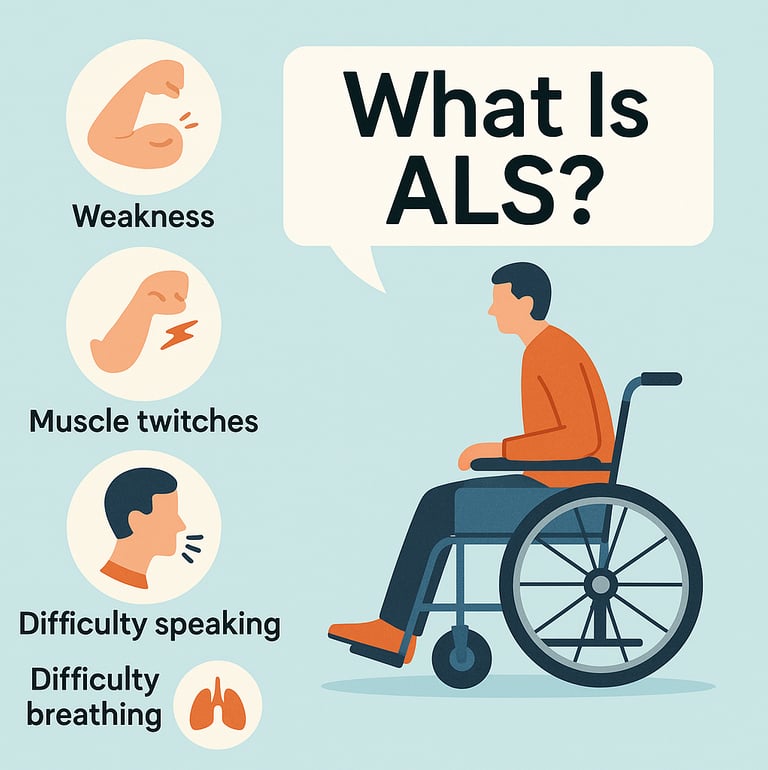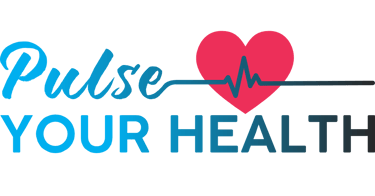Stay updated on what is trending in health. Discover tips and resources for a healthier, balanced life.
What Is Amyotrophic Lateral Sclerosis (ALS)? A Clear Guide to Understanding Lou Gehrig’s Disease
What Is Amyotrophic Lateral Sclerosis (ALS)? Learn about symptoms, causes, diagnosis, treatment options, and supportive care for amyotrophic lateral sclerosis in this easy-to-understand guide.
DISEASES AND CONDITIONS
Dr. S. Ali
6/22/20256 min read


Have you heard about ALS but aren’t quite sure what it is? Maybe you’ve seen a news story or heard about the famous Ice Bucket Challenge that raised awareness a few years ago. If so, you’re not alone. ALS, also known as Lou Gehrig’s disease, is a condition that affects thousands of people around the world. But what exactly is it? How does it affect the body? And is there anything you can do if you or a loved one is diagnosed? Let’s dive into it.
What Is ALS?
ALS stands for Amyotrophic Lateral Sclerosis. It’s a progressive neurological disease that attacks the nerve cells (called motor neurons) in the brain and spinal cord. These motor neurons are responsible for sending messages from your brain to your muscles, allowing you to move, speak, eat, and breathe.
When someone has ALS, these motor neurons gradually die. As the disease progresses, the brain can no longer communicate with the muscles, leading to weakness, paralysis, and eventually loss of vital functions.
A Quick Note: ALS vs. ASL — Not the Same Thing
Sometimes people accidentally search for ASL when they mean ALS. It’s an easy mix-up! But these are two very different things. ALS (Amyotrophic Lateral Sclerosis) is a progressive neurological disease. ASL, on the other hand, usually refers to American Sign Language, a completely unrelated topic. If you’re looking for information on ALS, you’re in the right place — and this article will help you understand the condition more clearly.
Why Is It Called Lou Gehrig’s Disease?
You might hear ALS called "Lou Gehrig’s disease," named after the famous American baseball player who was diagnosed with it in the 1930s. Lou Gehrig helped bring national attention to this rare and devastating illness.
The Ice Bucket Challenge and ALS
In 2014, ALS gained worldwide attention through the viral Ice Bucket Challenge. Millions of people, from celebrities to everyday folks, dumped buckets of ice water over their heads on video — and challenged others to do the same — to raise awareness and funds for ALS research. The campaign was hugely successful: it raised over $220 million globally and helped fund important scientific breakthroughs that are still shaping ALS research today.
How Common Is ALS?
ALS is considered a rare disease. About 2 out of every 100,000 people are diagnosed with ALS each year. In the United States, it’s estimated that about 16,000 people are living with ALS at any given time.
Who Gets ALS?
Anyone can develop ALS, but certain factors can increase the risk:
Age: Most people are diagnosed between the ages of 40 and 70.
Gender: Men are slightly more likely than women to develop ALS.
Genetics: About 5-10% of ALS cases are inherited (called familial ALS).
Environmental Factors: Some studies suggest that military veterans may have a higher risk, possibly due to environmental exposures.
What Causes ALS?
The exact cause of ALS isn’t fully understood. For most people, it seems to occur randomly without a clear reason (called sporadic ALS). In familial ALS, specific gene mutations are passed down through families.
Researchers believe that a combination of genetic, environmental, and lifestyle factors likely contribute to the disease. There’s still much to learn, and ongoing research is helping uncover more about the underlying causes.
Early Symptoms of ALS
One of the tricky things about ALS is that its early symptoms can be subtle and easy to miss. They often start with mild muscle weakness or stiffness. Common first signs include:
Trouble walking or running
Tripping or stumbling
Weakness in the hands or legs
Slurred speech
Muscle cramps or twitching (fasciculations)
Difficulty with simple tasks like buttoning a shirt
These symptoms gradually worsen over time.
How Does ALS Progress?
As ALS advances, it spreads to other parts of the body. Muscle weakness becomes more severe, and people may begin to experience:
Loss of ability to use arms and legs
Difficulty swallowing (dysphagia)
Trouble speaking clearly (dysarthria)
Shortness of breath as respiratory muscles weaken
Eventually, most voluntary muscles are affected. However, it’s important to note that ALS does not affect the senses (sight, smell, taste, hearing, or touch) or the mind. Many people with ALS remain mentally sharp even as their physical abilities decline.
How Is ALS Diagnosed?
There’s no single test for ALS. Diagnosis is based on a combination of medical history, physical exams, and ruling out other conditions. Tests that may be used include:
Electromyography (EMG): Measures electrical activity in muscles.
Nerve conduction studies: Assess how well nerves send signals to muscles.
MRI scans: Help rule out other brain and spinal cord issues.
Blood and urine tests: Look for other possible causes of symptoms.
Genetic testing: May be done if familial ALS is suspected.
Because ALS can mimic other diseases, getting a diagnosis can sometimes take time.
Is There a Cure for ALS?
Sadly, there is no cure for ALS at this time. However, treatments can help manage symptoms, slow disease progression, and improve quality of life.
Available Treatments
While there is currently no cure for ALS, there are treatments available that can help slow the progression of the disease and improve quality of life. Certain medications may help preserve muscle function for longer, manage symptoms, and possibly extend survival. Ongoing research continues to explore new therapies and promising treatments for the future.
Supportive Care: Improving Quality of Life
In addition to medications, supportive care plays a crucial role in helping people with ALS live more comfortably and maintain independence for as long as possible. This kind of care is tailored to the individual’s needs and can greatly enhance quality of life. It often involves a team of healthcare professionals working together. Here are some of the most common types of supportive care:
Physical therapy: Helps maintain mobility, flexibility, and muscle strength, reducing stiffness and discomfort.
Occupational therapy: Offers techniques and tools to assist with everyday activities like dressing, eating, or using the bathroom.
Speech therapy: Helps with communication as speech becomes more difficult. Therapists can also introduce alternative communication methods, such as computer-based speech devices.
Nutritional support: Ensures adequate nutrition and prevents weight loss, which is important for overall strength and energy. In some cases, feeding tubes may be recommended as swallowing becomes difficult.
Breathing support: Devices such as non-invasive ventilation (like BiPAP) can assist with breathing as the muscles weaken. This can improve sleep and help manage symptoms of breathlessness.
Assistive devices: Tools such as wheelchairs, walkers, communication aids, and home modifications (like ramps or grab bars) can promote independence and safety.
Supportive care doesn’t just focus on physical needs — emotional support for both patients and their families is also important, as coping with ALS can be incredibly challenging.
Living With ALS
A diagnosis of ALS can feel overwhelming, but many people with ALS continue to find joy and meaning in their lives. Support from family, friends, healthcare providers, and ALS organizations can make a big difference.
Tips for Coping:
Stay connected: Don’t isolate yourself. Stay in touch with loved ones and support groups.
Plan ahead: Discuss care preferences with your healthcare team and loved ones.
Focus on what you can do: Adapt routines and find new ways to enjoy activities.
Seek professional support: Counseling can help you and your family cope emotionally.
Promising ResearchScientists are working hard to understand ALS better and find new treatments. Promising areas of research include:
Gene therapy
Stem cell therapy
Targeted drug development
Clinical trials are ongoing, and there is hope that new breakthroughs will improve outcomes for those with ALS in the future.
Where to Find Support
If you or a loved one is facing ALS, you’re not alone. Many organizations provide valuable resources:
ALS Association: www.als.org
Muscular Dystrophy Association (MDA): www.mda.org
International Alliance of ALS/MND Associations: www.als-mnd.org
In Conclusion
ALS is a challenging disease, but understanding it is the first step toward managing it. Whether you’re learning about ALS for the first time or seeking resources for yourself or a loved one, know that support, research, and hope are all growing. Staying informed and connected can help make the journey easier.
Remember: Awareness matters. By learning about ALS, sharing knowledge, and supporting research, we can all play a part in moving toward better treatments and, one day, a cure.
Sources:
ALS Association
https://www.als.org/understanding-als
Mayo Clinic - ALS (Amyotrophic Lateral Sclerosis)
https://www.mayoclinic.org/diseases-conditions/amyotrophic-lateral-sclerosis
CDC - ALS
https://www.cdc.gov/als
National Institute of Neurological Disorders and Stroke (NINDS)
https://www.ninds.nih.gov/health-information/disorders/amyotrophic-lateral-sclerosis-als
Johns Hopkins Medicine - ALS
https://www.hopkinsmedicine.org/health/conditions-and-diseases/amyotrophic-lateral-sclerosis-als
NHS (UK) - Motor Neurone Disease (MND/ALS)
https://www.nhs.uk/conditions/motor-neurone-disease
European Network for the Cure of ALS (ENCALS)
https://www.encals.eu
ALS Canada
https://als.ca/about-als/what-is-als
World Federation of Neurology - ALS Resources
https://wfneurology.org/activities/als-resources
PubMed - ALS Latest Research
https://pubmed.ncbi.nlm.nih.gov/?term=amyotrophic+lateral+sclerosis
Pulse Your Health
Empowering you to achieve your health goals.
Contact
© 2025. All rights reserved.
Disclaimer: The content on this website is for informational purposes only and is not medical advice. Always seek the advice of your physician or other suitably qualified healthcare professional for diagnosis, treatment and your health related needs.
